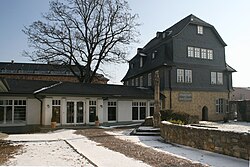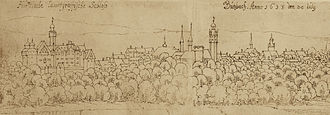Museum of the city of Butzbach
 Museum of the city of Butzbach. Exterior view with the historic Solms-Braunfelser Hof on the right and a copy of a giant Jupiter column in the foreground. |
|
| Data | |
|---|---|
| place | Butzbach |
| Art |
city history museum
|
| operator |
City of Butzbach
|
| management | |
| Website | |
| ISIL | DE-MUS-031014 |
The Museum of the City of Butzbach is a town history museum in Butzbach in the Wetterau district in Hesse .
history
The museum was founded in 1894/95 as an antiquities and costume museum . The Butzbach History Society was founded in 1900 and looked after the museum for decades. The city has been looking after the museum on a full-time basis since 1977.
Between 1907 and 1991 the museum was located in the Gothic Michaelis Chapel. 1990–1993 / 94 a contemporary museum building was built on an area between the two Butzbacher castles ( Landgräfliches Schloss Butzbach and Solmser Schloss ), consisting of the historic old building of the Solms-Braunfelser Amtshaus from the 15th century and an attached new building. The museum contains several rooms for special exhibitions as well as a lecture room. The rooms of the Butzbach city archive are connected to the museum.
collection
The collection has been shaped by the collection activity that has started since the museum was founded. The traditional costumes of the 18th – 20th Century, which could be preserved by taking over the museum holdings.
Roman times
The cellar in the historical part of the building is largely reserved for the archaeological holdings from Roman times . The Butzbach fort was an important military base on the Wetterau Limes as part of the Upper German-Raetian Limes . The small fort Degerfeld was still located in the Butzbach city area .
A model of the 3.3 hectare cohort fort Hunneburg is embedded in the floor of the large exhibition room. Numerous finds from the fort and the camp village ( vicus ) are exhibited in the showcases , including particularly large quantities of ceramics. The storage cellar of a Roman potter was reconstructed in a back room. The exhibition is complemented by stone monuments. A small Mercurius altar should be emphasized, which was discovered in 1913 when the old Griedel church was demolished.

City history
Six rooms on the first floor lead through the history of Butzbach, which was elevated to the rank of town in 1321. The exhibition begins with a copy of the epitaph of Philip VIII von Falkenstein from the Markuskirche. In addition to a city model and other city views, the models of several large buildings are worth seeing, including two churches, the Landgravial Palace and the fortress-like Philippseck Palace near Münster . One focus of the exhibition is the time of Butzbach as the residence of the Hessen-Darmstadt branch line under Landgrave Philip III. from Hessen-Butzbach . Philip was considered a learned sovereign who promoted science. He had an observatory set up in the castle and twice visited Johannes Kepler . This important historical epoch of Butzbach is illustrated by sketches by Valentin Wagner , who stayed in Butzbach in 1631/32. The exhibition is supplemented by original furniture, pictures, weapons and smaller productions.
Folklore Department
The folklore section on the second floor shows traditional Wetterauer and Hüttenberg costumes. The museum's extraordinarily rich inventory of traditional costumes is explained by the initial orientation of the museum and subsequent decades of collecting activity. In the exhibition, various life situations (baptism and birth, spinning room, rural daily life, wedding procession, death and mourning, as well as land travel and emigration) are reproduced at that time.
Crafts and trades in the old Butzbach
The “Crafts and Trades” department is located in the new building of the museum. It depicts local handicrafts ( weavers , blue dyers , tanners , potters , woodworkers, metalworkers) and illuminates the organization of the handicrafts in guilds that predominate in the city of Butzbach .
Butzbach in the age of industrialization
The large-scale exhibition on industrialization is also located in the new building . The focus here is on electrification , the Butzbacher Zeitung founded in 1848 and local industrial companies such as a pasta factory, a factory for agricultural equipment, a brewery (Gambrinus Brewery Melchior), paint factory, dry cleaning, locomotive factory and abrasives factories. A large overview model shows the extensive factories of what was once the largest local company (Bamag-Meguin).
The miniature shoe museum of the Butzbach master industrial shoemaker Richard Fenchel on the first floor of the new building is unique in this collection . Over 200 miniature models from Stone Age fur shoes to astronaut shoes explain the “cultural history of the European shoe”.
literature
- Monika Eschner: Museums in Hessen. A handbook of the publicly accessible museums and collections in the state of Hesse. 4th completely revised and expanded edition. Hessischer Museumsverband, Kassel 1994, ISBN 3-9800-508-8-2 , p. 163f.
- Dietwulf Baatz : Butzbach FB. Local museum. In: D. Baatz, Fritz-Rudolf Herrmann (ed.): The Romans in Hessen. 3. Edition. 1989. Licensed edition. Nikol, Hamburg 2002, ISBN 3-933203-58-9 , p. 248.
Web links
- www.butzbach.de Official website of the museum
Individual evidence
- ↑ For the historical building, see State Office for the Preservation of Monuments in Hesse (ed.): Farbgasse 16. Rent office of the Counts of Solms-Braunfels In: DenkXweb, online edition of cultural monuments in Hessen
- ^ History of the museum ( Memento from September 20, 2008 in the Internet Archive )
- ↑ CIL 13, 11949
- ↑ a b Dieter Wolf: Butzbach. A small princely residence during the Thirty Years War. In: Holger Th. Gräf and Helga Meise (eds.): Valentin Wagner. A draftsman in the Thirty Years War. Exhibition catalog Hessisches Landesmuseum Darmstadt 2003, ISBN 3-921254-92-2 , pp. 61–70.
- ↑ see Siegfried Rösch: Landgrave Philipp III. by Hessen-Butzbach and Johannes Kepler. Wetterauer Geschichtsblätter, Volume 24. Friedberg, Hessen 1975, pp. 99-108.
Coordinates: 50 ° 25 ′ 58.9 ″ N , 8 ° 40 ′ 24.9 ″ E
